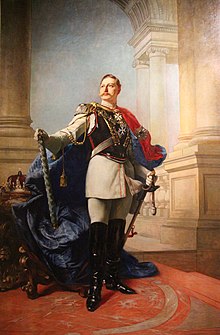Wilhelminism
| 1890–1918 | |
 | |
| Including | Gründerzeit |
|---|---|
| Followed by | Weimar culture |
| Monarch(s) | Wilhelm II |
The Wilhelmine Period comprises the period of German history between 1890 and 1918, embracing the reign of Kaiser Wilhelm II in the German Empire from the resignation of Chancellor Otto von Bismarck until the end of World War I and Wilhelm's abdication during the November Revolution. It had remarkable impact on the society, politics, culture, art and architecture of Germany and roughly coincided with the Belle Époque era of Western Europe.
Characteristics[]
The term "Wilhelminism" is not meant as a conception of society associated with the name Wilhelm, and traceable to an intellectual initiative of the German Emperor. Rather, it relates to the image presented by Wilhelm II, and his demeanour, manifested by the public presentation of grandiose military parades, and self-aggrandisement on his part, this latter tendency having already been noticed by his grandfather Emperor Wilhelm I during the period that Wilhelm's father Frederick was Crown Prince.
Wilhelminism also characterizes the social and cultural climate of the reign of Wilhelm II, which found expression in rigidly conservative attitudes relying on the Prussian Junker landowners and associated in the German Agrarian League. Thereby resembling the Victorian era in the United Kingdom, at the same time, the period was distinguished by an extraordinary belief in progress, which, while contributing to the enormous prosperity of the highly industrialised German Empire, was at odds with its social conservatism. Though Bismarcks's Anti-Socialist Laws were not renewed, Wilhelm's government continued to implement measures against Socialist ideas. Nevertheless, the Social Democratic Party continued to grow in strength and became the largest faction in the Reichstag (parliament) upon the 1912 elections. With stronger influence, the internal developments were characterised by an increasing loyalty of the party establishment towards Emperor and Reich; an attitude that was condemned as "revisionism" by its opponents and culminated in the Burgfrieden policy of granting loans to fund the German effort in World War I.
Foreign policies were founded on Wilhelm's imperialist ambitions and directed towards the establishment of Germany as a world power (Weltmacht); the desire for a "place in the sun" as coined by Secretary of State Bernhard von Bülow was shared by a large number of German citizens and intellectuals. German nationalism achieved a short-lived high point, following the acquisition of some colonial possessions on the African continent and in the South Seas, while external relations deteriorated: in 1890, Germany had refused to prolong the secret Reinsurance Treaty with Russia, concluded by Bismarck in 1887, and had to witness the forming of the Franco-Russian Alliance presenting a new two-front war scenario. The relations with the British were not only strained by the "Scramble for Africa" but also by the Anglo-German naval arms race. Wilhelm's fascination with the German Navy, and his ambition to see it established as an instrument for the projection of world power, were reflected in everyday German life. Even until the middle of the twentieth century, boys were dressed in sailor suits, and in this way were impressed at an early age with the Navy's aura and prestige.

The distinctive spiked helmet, the so-called Pickelhaube, although it had existed previously, and not only in the German Empire, was symbolic for the Wilhelmine period, for the Imperial Army, and German militarism in general (in various sign languages, the extended forefinger placed in front of the forehead, indicating the spiked helmet, is still the sign for "German"). The term is equally applied to the distinctive styles prevailing in the visual arts and architecture of the period, for example the ornate Germania postage stamps,[1] numerous government buildings as well as the Wilhelmine Ring housing areas of Berlin and many other German cities. It is also used to describe, among other things, an essentially Neo-Baroque, extraordinarily prestige-oriented style of architecture calculated to give expression to the German state's claim to imperial power. This style was particularly exemplified by the grandiose Siegesallee, a boulevard of sculptures lampooned by Berliners as Puppenallee ("mall of dolls"), and was given official status by Wilhelm's so-called "Rinnsteinrede" ("gutter speech") on what he considered modernist degenerate art at the inauguration of the extravagant boulevard on December 18, 1901.
See also[]
Literature[]
- Geoff Eley (ed.) and James Retallack (ed.): Wilhelminism and Its Legacies. German Modernities and the Meanings of Reform, 1890-1930. Essays for Hartmut Pogge von Strandmann. Berghahn Books, New York and Oxford, 2003
- R. J. Evans (ed.) and Hartmut Pogge von Strandmann (ed.): The Coming of the First World War. Clarendon Press, 1990.
- John C. G. Röhl: The Kaiser and His Court: Wilhelm II and the Government of Germany. Cambridge University Press, 1966.
- John C. G. Röhl: Wilhelm II : The Kaiser's Personal Monarchy, 1888-1900. Cambridge University Press, 2004.
- John C. G. Röhl: Kaiser, Hof und Staat. Wilhelm II. und die deutsche Politik. C. H. Beck, Munich ³1988 (TB 2002), ISBN 978-3-406-49405-5.
- John C. G. Röhl: Wilhelm II., C. H. Beck, Munich 1993–2008:
- Volume 1: Die Jugend des Kaisers, 1859–1888. Munich 1993, ²2001, ISBN 3-406-37668-1.
- Volume 2: Der Aufbau der Persönlichen Monarchie, 1888–1900. Munich 2001, ISBN 3-406-48229-5.
- Volume 3: Der Weg in den Abgrund, 1900–1941. Munich 2008, ISBN 978-3-406-57779-6. (online review by Lothar Machtan, Institut für Geschichtswissenschaft, Bremen University on http://hsozkult.geschichte.hu-berlin.de/)
- Fritz Fischer: Griff nach der Weltmacht. Die Kriegszielpolitik des kaiserlichen Deutschland 1914/18 (1961), Droste 2000 (reprint of special edition, 1967), ISBN 3-7700-0902-9.
References[]
External links[]
- Zeitreise – exhibition in Nordrhein-Westfalen
- Preußen – Chronik eines deutschen Staates (ARD series during “Preußenjahr“ 2001)
- Warum der Wilhelminismus als politischer Kampfbegriff nichts taugt - Die Zeit, February 1999
- German Empire
- Wilhelm II, German Emperor
- Periodization
- Historiography of Germany